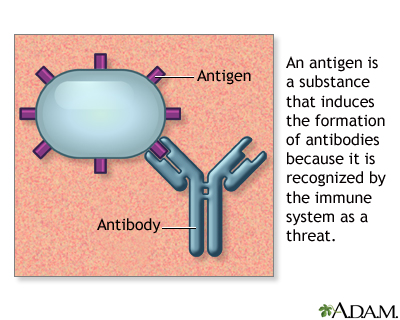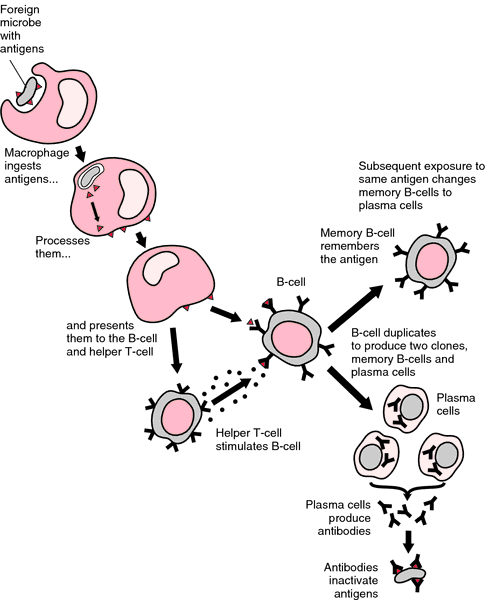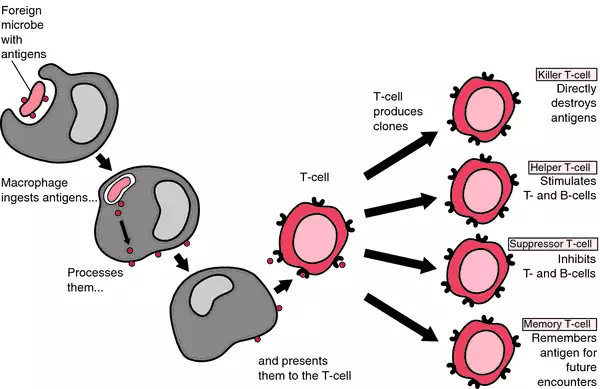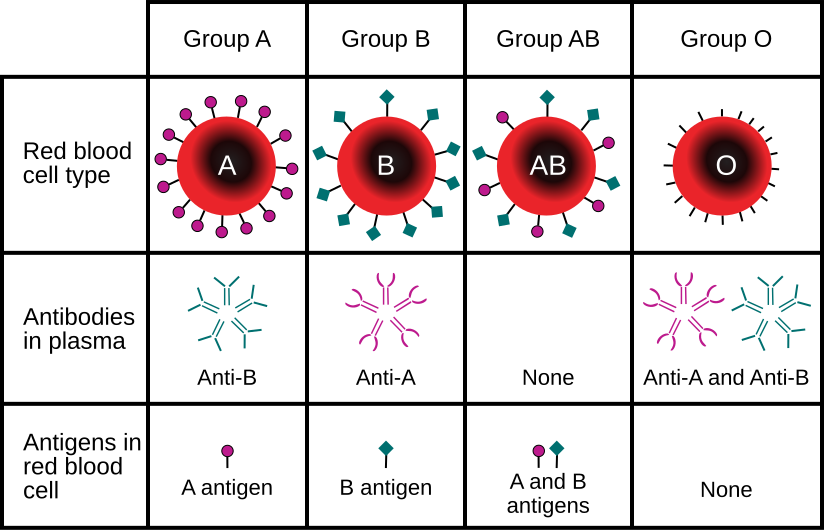Defending our bodies from pathogens (viruses, bacteria, fungi, worms, etc) is a complex and continuous challenge. Our immune system carries out this function in a variety of ways. The lymphatic system and the circulatory system both play an important role in transporting fluids and their cellular and molecular contents around the body, to guarantee that defenses are available where needed and when needed. Cells and proteins that take part in our immune responses are shown below. We will be talking about quite a few of them. Once we have covered the whole topic, come back and see which ones we have discussed.
1. Non-specific Defense (innate immunity)
a. Prevent Entry
- skin: stops bacteria and viruses from entering
- "good" bacteria that live on skin outcompete "bad" bacteria
- hair and cilia in nasal passages trap dust and other particles in the air, preventing their entry into the respiratory system
- mucus traps bacteria and viruses
- coughing, sneezing and vomiting force "invaders" out of the body
- blood clotting prevents entry though injuries
b. General destroying methods
- acidity of stomach (pH=2) and fever cause denaturation of most proteins, therefore destroying the cells they are found in
- interferons are a group of signalling proteins that are released by infected cells, signalling to neighbouring cells to heighten their defenses
- the complement system is a group of small proteins found in the blood. When triggered, they join together to form a hole in the membrane of an invading cell, called the membrane attack complex (MAC). This hole allows extracellular fluids to rush into the cell, causing it to expand and burst.
 |
2. Specific Defense (adaptive immunity)
- requires the lymphatic system
- takes approximately 5-7 days to become activated
- based on the recognition of a specific foreign cell based on particles (called antigens) on the cell's surface
The Lymphatic System
The function of the lymphatic system is to filter the fluid that enters its vessels and then return it to the bloodstream. Tissue fluid enters the lymphatic vessels, and is then called lymph. Lymph consists of water, glucose and white blood cells.
Lymph travels from dead-end lymphatic capillaries though the lymphatic veins to the lymph nodes and organs, where it is filtered of bacteria and cellular debris, helping to fight disease. Lymph nodes also store T and B cells (more on these in a bit), which also play important roles in immune function.
Movement through lymph vessels requires the help of muscular contractions and suction force near the vena cava, as the lymph system doesn't have a heart. Lymphatic veins connect into the bloodstream at the vena cava near the heart, returning filtered lymph into the bloodstream.
 |
| Dead-end lymph capillaries collecting tissue fluid from the tissue spaces |
Secondary lymphatic organs play a major role in filtering foreign matter from the body. The spleen (lép) is an elongated organ found behind the stomach. Its function is to filter blood, in particular to remove old red blood cells from circulation. Tonsils and adnoids (garat és orrmandulák), as well as the appendix and patches in the intestines and lymph nodes make up the rest.
Two Types of Specific Immune Responses
 | ||||||
Two immune responses exist: cellular-mediated response and anti-body mediated response.
In the cell-mediated response a T-cell is presented with a foreign antigen (by a macrophage) and is activated. Once activated, the T-cell divides to form 4 different kinds of cells: killer T-cells, helper T-cells, suppressor T-cells and memory T-cells.
Killer T-cells will directly destroy any cells carrying the antigen that the T-cell responds to.
Helper T-cells stimulate more T-cells and B-cells to respond to the invader.
Suppressor T-cells will inhibit T-cells and B-cells once the numbers of antigen-carrying invaders has drop, in order to "end the battle"
Memory T-cells will be stored up in lymph nodes in order to allow for a more rapid response the next time the body comes in contact with that same pathogen.
In the antibody-mediated response B-cells are presented with antigens by macrophages and stimulated by helper T-cells. The B-cells then divide to form memory B-cells and plasma cells.
Memory B-cells will be stored away to allow for a faster response to future infections.
Plasma cells divide and produce antibodies.
 |
Antibodies (antitestek) or immunoglobulins are small proteins with a very specific structure. They are made up of 2 heavy chains and 2 light chains, forming a Y-shaped structure. One part of the structure is constant and common to all antibodies of that type (there are 5 different classes of antibodies/immunoglobulins depending on the type of immune response or the stage of immune response that they participate in). Two ends are made up of variable amino acids, resulting in those ends being specific to a given antigen, therefore they are the antigen-binding sites.
 |
| Antibody structure |
Antibodies bind to antigens found on the surface of cells, forming the antigen-antibody complex.
Once a cell is bound to an antibody, it essentially can no longer function or cause infections. The various ways in which antibody-binding does this are shown below.
SO.....
To recap what has been stated, cell-mediated and antibody-mediated responses are shown in the following diagrams.
When discussing immunity, it can be divided into innate and adaptive responses, as listed above. Beyond that, adaptive responses can be either natural or artificial and those can be active or passive, as shown in the table below.
Newborn babies have passive natural immunity, as their body contains antibodies passed from their mothers via the umbilical cord. As the antibodies break down with time, this immunity decreases, but antibodies are also passed via breast milk, thus the importance of breastfeeding young babies. Babies who are formula-fed often get more infections in their first weeks/months of life. Active natural immunity develops when a person come in direct contact with a pathogen and their system builds defenses to it. Passive artificial immunity occurs when someone gets serum containing antibodies in order to protect them for a short period of time. A typical example is if someone were to be bitten by a poisonous snake. As quickly as possible they should be taken to a doctor, who can then administer a serum containing antibodies to the snake venom, thus rendering the venom harmless. This, of course, does not provide the person with long-term immunity to snake venom. Active artificial immunity is the standard situation with immunisations. The body comes in contact with a dead or weakened pathogen and builds its own defenses to it, thus storing up memory T-cells and B-cells, so developing long-term immunity. Hungarian children are immunised against a variety of illnesses, including tuberculosis (BCG vaccine), Haemophilus influenzae, diptheria, whooping cough, tetanus, polio, measles, mumps, rubeola and hepatitis B. Such required vaccinations have led to a worldwide decrease in childhood diseases, significantly reducing childhood death statistics.
Blood Groups
Blood groups provide us with a way to understand how the immune system works. There are a number of antigens found on our red blood cells, but the best known is the ABO antigen group. Some people have Type A blood, meaning they have the A antigen, while others are Type B, so they have the B antigen. Some people are Type AB, so they carry both the A and B antigen, while people with Type O blood have neither A nor B antigens on their cells' surfaces. People always create the antibodies against those antigens that they don't have.
What this means is that if a person with Type A blood is given a blood transfusion containing Type B blood, since they have antibodies against the B antigen, that blood from the transfusion will agglutinate, or in other words, Anti-B antibodies will bind to the Type B blood cells and cause them all to stick together, forming a clump of blood, which naturally will be too big to flow through capillaries, therefore blocking the flow of blood, potentially leading to thrombosis, stroke or death.
So.....
People with Type A blood can only accept Type A blood or Type O blood (which doesn't have antigens) and so on. This means that people with Type AB blood are universal acceptors, because they can accept blood from Type A, B, AB and O, while people with Type O blood are universal donors, since they can donate their blood to any of the groups (but can only accept Type O blood!).
A second antigen system found on red blood cells is the Rh factor. People either have it and are called Rh+ or they lack it and are Rh-.
This factor must also be taken into consideration for blood donations, as people who are Rh- have anti-Rh antibodies and thus run into problems if they come in contact with Rh+ blood. This is a notable problem at childbirth. A mother who is Rh- has no anti-Rh antibodies if she has never come in contact with Rh+ blood, so if she is carrying an Rh+ child this is likely not a problem during the first pregnancy. But if, at childbirth, some of the child's Rh+ blood, that flows in the placenta and umbilical cord, gets into the mother's system (highly likely), then she will start to produce anti-Rh antibodies. Then if she becomes pregnant again with another Rh+ baby, her body will mount an immune response to the fetus, resulting in a miscarriage. Nowadays, Rh- women are given a serum immediately following childbirth to rapidly bind the Rh+ antigens and prevent her body from mounting an immune response.
Here are some sites with games and explanations about the immune system. Just for fun!
Tissues Invaders
Super healers
Immune system defender
Blood groups provide us with a way to understand how the immune system works. There are a number of antigens found on our red blood cells, but the best known is the ABO antigen group. Some people have Type A blood, meaning they have the A antigen, while others are Type B, so they have the B antigen. Some people are Type AB, so they carry both the A and B antigen, while people with Type O blood have neither A nor B antigens on their cells' surfaces. People always create the antibodies against those antigens that they don't have.
What this means is that if a person with Type A blood is given a blood transfusion containing Type B blood, since they have antibodies against the B antigen, that blood from the transfusion will agglutinate, or in other words, Anti-B antibodies will bind to the Type B blood cells and cause them all to stick together, forming a clump of blood, which naturally will be too big to flow through capillaries, therefore blocking the flow of blood, potentially leading to thrombosis, stroke or death.
So.....
People with Type A blood can only accept Type A blood or Type O blood (which doesn't have antigens) and so on. This means that people with Type AB blood are universal acceptors, because they can accept blood from Type A, B, AB and O, while people with Type O blood are universal donors, since they can donate their blood to any of the groups (but can only accept Type O blood!).
A second antigen system found on red blood cells is the Rh factor. People either have it and are called Rh+ or they lack it and are Rh-.
This factor must also be taken into consideration for blood donations, as people who are Rh- have anti-Rh antibodies and thus run into problems if they come in contact with Rh+ blood. This is a notable problem at childbirth. A mother who is Rh- has no anti-Rh antibodies if she has never come in contact with Rh+ blood, so if she is carrying an Rh+ child this is likely not a problem during the first pregnancy. But if, at childbirth, some of the child's Rh+ blood, that flows in the placenta and umbilical cord, gets into the mother's system (highly likely), then she will start to produce anti-Rh antibodies. Then if she becomes pregnant again with another Rh+ baby, her body will mount an immune response to the fetus, resulting in a miscarriage. Nowadays, Rh- women are given a serum immediately following childbirth to rapidly bind the Rh+ antigens and prevent her body from mounting an immune response.
Here are some sites with games and explanations about the immune system. Just for fun!
Tissues Invaders
Super healers
Immune system defender












No comments:
Post a Comment